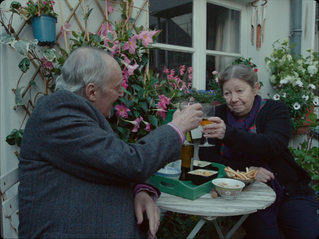Walker
- Jonny Rogers
- Jul 14, 2021
- 3 min read
Tsai Ming-liang, 2012

Amidst an ocean of flashy adverts, car horns, jingles and the white noise of mindless chatter, restless pedestrians stop only to watch a man walking slowly, many unable to disseminate this encounter without the mediating gaze of a phone or camera. The near stillness of his movement renders even the casual stroll an obtrusive gesture, silently revealing each gaudy poster or neon-adorned billboard a banal cry for the attention it never receives.
And yet, despite its patience-demanding minimalism, I find something deeply and richly entertaining in Tsai Ming-liang’s Walker, the second part of a series of films featuring Lee Kang-sheng as a robed monk traversing various locations across the globe. In these films, which seemingly defy any clear distinction between narrative, documentary, and performance art, Ming-liang combines the spiritual practises of pilgrimage and walking meditation (kinhin) to offer a playful protest against the organising principles of the urbanised world: the unquestioned exaltation of busyness, noise, and distraction, all conducive to sustaining the constant flow of consumption.
But what is so provocative about the act of walking slowly? Why is it so strange to observe such intensity of focus?
The answer lies, in part, in how the world has changed over the past century. Due to rapid developments in technology and transportation, the space between places is, in a sense, folding in; given the right resources, we can travel almost anywhere in the world within only a matter of hours or days. As Marc Augé observed, the rise of globalisation has birthed an expansive proliferation of ‘non-places’, or liminal sites which we inhabit only as a temporary, anonymous resident: in train stations, bus stops, airports, hotels, corporate buildings, commercial centres, and so forth.
Where houses serve to provide rest and security, and religious buildings serve to facilitate worship and community, ‘supermodern’ spaces are characteristically constructed around the principle of mass transit. As such, urban planners and corporate architects alike most often prioritise the arrangement of elements that will bring the greatest amount of people through the given space as quickly as possible (often while also attempting to stimulate maximal frivolous expenditures).

Hence, for the cult of efficiency, slowness is the highest sin. Why take thirty minutes doing what might only take five? In fact, why should anyone care to watch a film about walking when there’s surely so many better uses of your afternoon?
Whatever answers you provide to these questions, I think the paradox of Walker is the heart of its brilliance: a man doing very little rewards our focus precisely because he does not ask for it. The crimson aura of our unhurried hero remains the sole object of permanence in this ever-changing city. He is a holy man consecrated not through his removal from the world, but through his triumphant indifference to its lies and illusions. His slow protest of intentional movement invites us to discover new ways of relating to the world with the dignity and purity of attention it deserves.
Where many of the greatest filmmakers infuse their work with the presence of masterful dialogue, images, or characters, Tsai Ming-liang infuses his image with the presence of time itself: an often-uncomfortable confrontation which quietly brings us to acknowledge our own inconsistencies as confused and lonely people, perpetually lost in exile from our true selves.
When Walker was released on Youku, a Chinese video streaming service, the film reportedly received thousands of complaints – some saying that the monk should be pushed or hit over the head to make him move faster. Whether or not these comments actually intended to endorse physical assault, you might still relate to this sentiment; there is, perhaps, something almost painful in watching this real-time slow motion. I suggest, however, that such irrational violence emerges from a deep dissatisfaction habituated through our constant exposure to ephemeral distractions in advertising, culture, and media.
In the film’s predictably placid denouement, a Taiwanese ballad plays as the monk begins to slowly consume the bo lo bao (pineapple bun) he has carried throughout the city; a delightfully strange resolution to an otherwise wordless celebration of Asia’s ascetic traditions. Nevertheless, this song seemingly renders his consumption an act of love, a passionate embrace of something beautiful and nourishing.









Comments